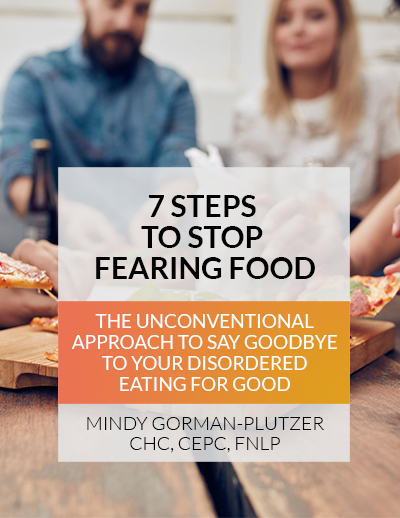The gift of mindfulness is that we can create the experience we are longing for simply by setting an intention for it. Just like when we set out to learn to ride a bike or improve our computer skills, we set our minds to the task without distraction. Easy it’s not, but the rewards are great. We need patience, gentleness and some degree of playfulness in order to succeed with the tasks of our lives. Those same virtues are vital as we learn to honor, respect and love our bodies, our selves.
Bringing mindfulness to the table allows and encourages us to do that.
Eating mindfully, with awareness, is powerful. It slows you down so you can honor your hunger and satiety. It creates the relaxation response that enhances digestion, nutrient assimilation and calorie burning.
Mindful eating is not about being obsessed with food choices or counting calories. Mindfulness is becoming aware of mind and body signals every time you eat. When you eat mindfully, you can observe different body cues that influence how, what and when you eat. Eating with awareness creates an easily attainable balance as you are in touch with your satiety.
These functions actually begin in the mind. Scientists call it the cephalic phase digestive response – CPDR. Cephalic means “of the head”. This phase of digestion is simply a more sophisticated way of identifying the pleasures of taste, smell, satiety, and the visual component of a meal. It actually is about how our minds digest what we are eating. Researchers estimate that 30-40 percent of the total digestive response to any meal is due to CPDR, the mental awareness of what we are eating.
Digestion begins as chemical and mechanical receptors on the tongue, the mouth and nose are stimulated by smelling food, tasting it, chewing it and simply noticing it. A true awareness of our meal begins the secretion of saliva, stomach acid and enzymes, neuropeptides, and production of the full range of pancreatic enzymes. At the same time, blood rushes to the digestive organs, the stomach and intestines begin to rhythmically contract and electrolyte concentrations get ready to receive the incoming food.
When you are not aware of your meal and the eating experience, neglecting to register any of the taste, smell, satiety or visual piece, you are only digesting and metabolizing at 60-70 percent of your capacity. This translates into less efficient digestion, nutrient absorption and metabolism.
In my work as a Certified Eating Psychology Coach, clients often share how much they have to do. There are errands to run, emails to read and respond to, the responsibilities to the business of our lives, work, and the demands of relationships to attend to. These to-do lists create the feeling that there just isn’t enough time in the day. They end up eating while running out the door, driving in the car, sitting in front of the TV or computer, talking on the phone, standing in front of the refrigerator or the stove, or while clearing the table. The result is there is no chance of pleasure or calm.
Do you restrict calories in an effort to control weight? Maybe you abuse food, using it to distract you from uncomfortable feelings. When food is used in either of these scenarios, the pleasure food can bring is ignored, as it is swallowed before it is even tasted.
When we question what we are eating, focusing our awareness on the fat and calories we perceive to be in our food, we can’t be mindful of the food or the experience. Like talking to a friend who isn’t paying attention, we leave the experience feeling incomplete, and wanting more.
The same phenomenon occurs when we are distracted with thoughts of guilt, shame and fear over our food choices. The donut, piece of chocolate or bowl of ice cream will go unnoticed. What we thought we wanted can’t bring any satisfaction – it’s hard to empower ourselves with choice when we don’t really let ourselves have it in the first place.
These distractions inhibit your ability to discover and savor the sight, smell, texture and taste of your food. By slowing down and adopting a mindful presence, you can fully experience the elements of your food, creating awareness of and satiety with appropriate portions, the balance I mentioned earlier.
When eating mindfully, you can appreciate and derive pleasure from your food. Eating becomes an exercise where you can engage your senses and be fully present in that pleasure. Pleasure is a huge part of the equation when transforming your relationship with food. When there is pleasure there is no guilt, no shame, no fear.
When our attention is directed outside of our bodies we can’t possibly experience the physical sensations connected with food. We can’t sense when we are full, the deliciousness of the food, or even if we like it.
One of the most effective strategies for developing a healthy relationship with food through mindfulness is embodiment. Simply stated, when we listen to our bodies’ cues, we learn to eat when we are hungry and stop when we’ve had enough. Embodiment allows us to connect with our bodies so we can honor and respect the space where we feel relaxed and present. In this space we experience the pleasure and can make empowered choices.
Practicing mindfulness and embodiment at the table will keep you from using food to check out. Embodiment reflects the wisdom of your body and how connected you are to it. Making empowered choices regarding what to eat, and when to eat it can only be realized when you include your body in the conversation. To rely on anything external such as the scale or a distorted image of your self distracts from mindfulness and embodiment.
Like the eater who has a healthy relationship with food and hunger, the mindful eater automatically checks in with her body for fullness and satiety cues. Even when multi-tasking she is aligned with her body’s message because the signals are clear and can be trusted. Mindful, healthy eaters breath during the meal, they chew well before swallowing, they pause often to enjoy the taste of the food. They focus on the food in front of them rather than what they may have eaten earlier in the day or planned for tomorrow.
Mindful eating introduces you to a new level of freedom. Relying on the natural intelligence and intuition of your body empowers you to trust yourself and embrace the deliciousness of what food and eating can do for you. Mindful eating actually opens you up to the possibility of developing not only a healthy relationship with food but a loving one.
Another very important piece to this is the awareness of WHY you are eating. Eating to satisfy a physical hunger is different from eating to satisfy an emotional hunger. Eating compulsively, thinking obsessively about everything you eat is not practicing a mindful and loving relationship with food nor your body. Craving, obsessing over, binging and restricting are not behaviors that reflect love. Eating this way, motivated by fear, guilt, or a need to check out from the day is indicative of a loss of control brought about by negative self-talk and shame. This behavior won’t let you enjoy food because you not only fear what it will do to you but you don’t think you’re allowed to enjoy it. So you eat the grilled chicken breast or burger without the bun and then find many other ways to eat what you think you really want while distracting yourself from the reality that you are eating.
Whatever you weigh, you’re entitled to find pleasure and joy in your food, just as you are entitled to find pleasure and joy in all you do.
Loving food is to smell it, taste it and savor it. A love affair with food gives new meaning to eating emotionally. That’s right – you are reading correctly, emotional eating can be wonderful. Eating with emotion as opposed to eating in order to deal with emotion is incredible. When you eat, eat, and experience the wonder and complexity of food.
Eating mindfully, soulfully, allows you to develop a healthy, and ultimately a wonderful, relationship with food.
What would your life be like if you treated food and your body as you would a loved one – with patience, gentleness, playfulness, communication, honesty, respect and love?
Here are some practical steps you can take in an effort to bring mindfulness to the table.
- Eat without distraction, while sitting at the table. Turn off the TV, computer, and phone. When your attention is somewhere other than the food on your plate, it won’t be on what’s happening in your body.
- Slow down and breathe. Deep, conscious breathing keeps you present and relaxed.
- Let go of any negative judgments about yourself and the food you are about to eat. Instead embrace the positive energy of the meal before you
- Experience the smell, taste and texture of your food, allow yourself the pleasure of feeling nourished.
As you become comfortable with eating slowly and mindfully, you’ll be paying close attention to your body’s cues, honor your hunger, stop when you’ve had enough, and become a willing and loving participant in the experience of here and now.






0 Comments